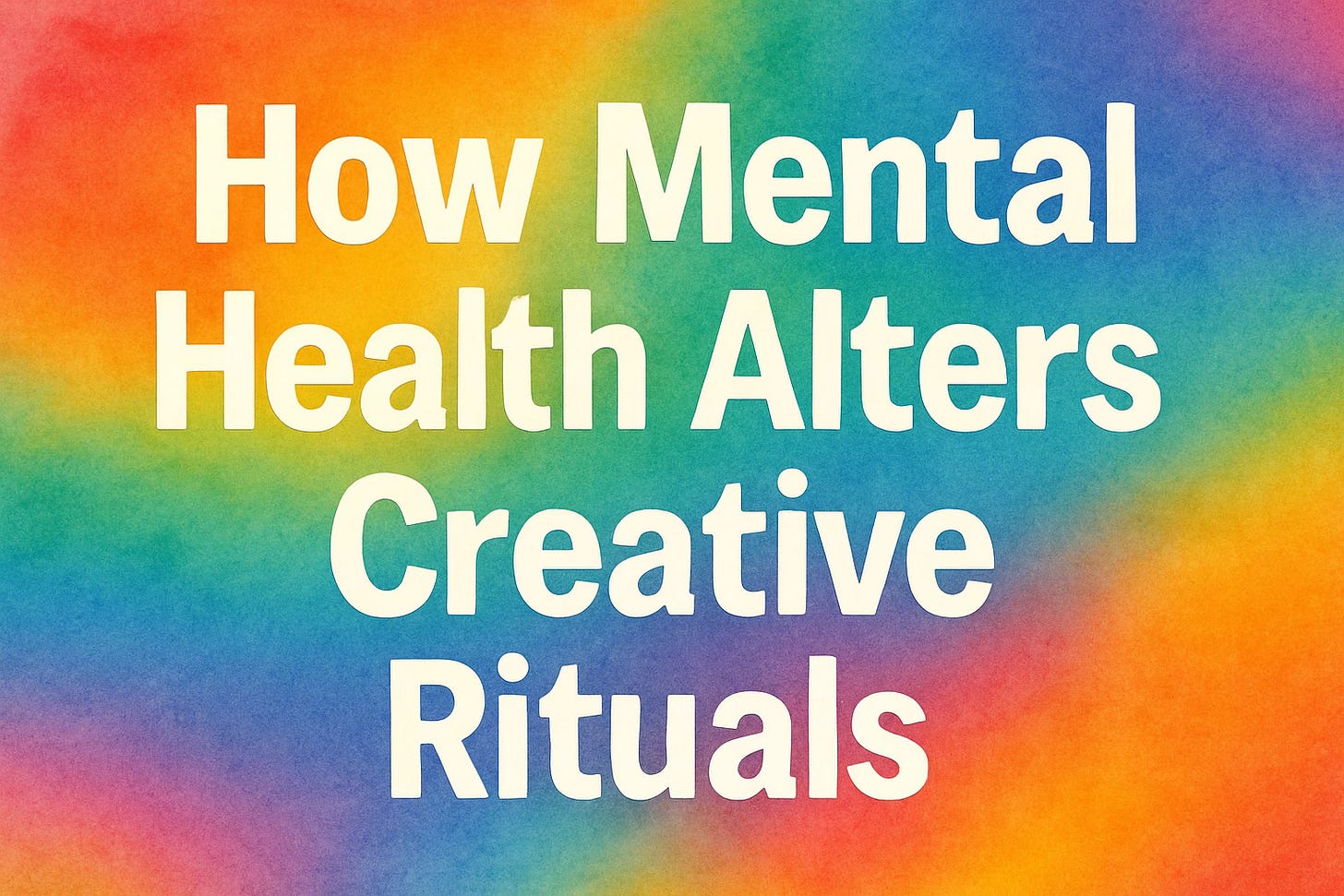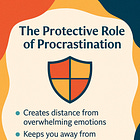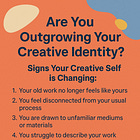When Process Fails: How Mental Health Alters Creative Rituals
If you miss a day, skip a week, or scrap a project, that does not erase you as an artist.
There have been times when even my favorite creative routine felt like a trap rather than a haven. I remember days when crochet, the rhythm of hook and yarn that once pulled me through despair, would lie limp in my lap. This craft pulled me out of a deep lifelong battle with depression. I have experienced it as healing for myself and seen it work miracles in healing so many others. Yet even that ritual could buckle under the weight of chronic illness or anxiety or grief. In those moments, no routine works.
It’s even more challenging with writing routines sometimes. Writing a paragraph feels like a climb up a mountain made of fog, as I’ve observed in my own life.
Rather than a simple failure of will, these breakdowns are warning signals from the brain and body. Mental and physical health challenges don’t mean the artist has failed. They mean our creative rituals need to change.
I have developed these ideas after decades of lived experience, interview-based insights, and deep research into the complex relationship between art and health. They are based on my unique 6-part framework.
If you are interested in assistance in applying these ideas to your own life: Order a Creative Health Assessment or Book a 1:1 Coaching Call.
When Creative Rituals Falter: Understanding Why and How
Most of us lean on creative rituals: small routines that cue our brains into a creative mode. Maybe it's sipping coffee while journaling, taking an afternoon walk for ideas, or tidying a workspace before starting a project. We trust these habits to spark inspiration or at least get us in the right mindset. They become anchors: "I always write 500 words before lunch," or "I do a crochet swatch every evening."
When they work, creativity flows smoothly. And I believe in the power of these. I use them regularly. They guide me.
But what happens when a ritual no longer works? When your alarm rings and nothing comes? When your heart pounds with worry as you draw a blank? These aren't personal failings; they might be your health speaking up. In my life, I've seen both. Chronic fatigue from depression meant sometimes I couldn’t lift a hook or open my laptop at all. In other episodes, panic would strike whenever I sat to write, until even a clean desk felt unsafe. I remember too well the guilt and frustration: I blamed myself.
But these breakdowns aren't character flaws. They are signals that your body and brain are overwhelmed. Recognizing this can significantly reduce shame and self-blame.
Here are some of the common causes …
Executive Dysfunction
Conditions like depression, ADHD, or chronic stress often involve executive function deficits. These are the brain skills that manage time, attention, and decisions. When these functions flag, the smallest creative task can feel overwhelming. It's not a lack of desire to create, but an inability to start or follow through.
Research shows that mental health struggles reliably impair working memory, planning, and focus, which are exactly the tools we need to execute a creative idea. Forcing yourself to stick to a rigid schedule on these days can increase frustration. For example, you might be unable to decide what to work on, or you start a project and forget key details, derailing the whole session.
This can intersect with your health or other facets of your ability. Environments and expectations can disable individuals with diverse cognitive functions, rather than solely blaming individual deficits.
Fatigue and Burnout
Emotional or physical exhaustion deeply impacts creative energy. Depression and chronic illness, for instance, often sap energy. This has been one of the most common ones for me personally.
Imagine trying to paint when every muscle aches. I've had mornings when I couldn’t even hold a pen steady, let alone pour out prose. I’ve had whole days like this. Okay, I’ve had whole months like this.
Creative rituals that once felt nourishing suddenly feel like obligations that exhaust even more energy. In creative professions, burnout is well-documented: studies describe it as a loss of the ability to generate novel ideas and maintain faith in the creative process. The world and your own work can feel flat and uninteresting when you're worn out. "Artist's block" is often just fatigue in disguise.
Research on creatives consistently shows that burnout leads to low motivation, anxiety, and irritability. When those symptoms set in, a structured routine doesn't magically spark creativity; it might actually make things worse by adding stress.
Anxiety and Fear
Fear and creativity have a complicated relationship. A little anxiety can sharpen focus, but too much hijacks our attention. It can inspire or it can impede.
When anxiety becomes overwhelming, creative work often stalls because the brain zeroes in on perceived threats, leaving no room for art. For a creative, this might look like avoiding posting work, endlessly revising out of fear, or not creating at all because it won't be "good enough." R
esearch echoes this: anxious individuals become less flexible and more wary, clinging to routine tasks rather than venturing into new creative territory. This defensive mode erodes spontaneity and can turn a playful sketch into a soul-crushing struggle against self-doubt.
Shifting Mood Rhythms
Many artists report that their creativity comes in waves. This is particularly true for those with bipolar or cycling mood conditions, but it can affect anyone experiencing chronic stress.
Sometimes you feel incredibly productive, churning out pages of writing; other days, you might slump and be unable to write a single line. This up and down pattern makes any fixed schedule feel unstable. On a high, you might miss a rigid meeting time and instead work frantically at midnight. On a low, you might skip work completely.
When our internal clocks are unsteady, rigid creative schedules can become impossible to maintain. We need to remember that creativity isn't a tap we can simply turn on at will when our internal "plumbing" is out of sync.

And so …
Each of these factors can crumble a rigid ritual. But notice what research and my own story emphasize: these are normal human experiences. We’re not defective for encountering them; we’re human.
In fact, reframing them can be empowering. For example, anxiety isn’t only a foe; sometimes it focuses attention or signals that something needs care. Creativity itself can heal anxiety and fatigue if approached gently. Indeed, the therapeutic power of art is well known. So when we must deviate from a plan, that detour can itself be a form of self care.
In a neuro affirming approach, we recognize that each brain has its own way of working, and that difference can include anxiety, ADHD, depression, or trauma. Brains come in all shapes. Creativity often thrives on these differences.
What does that mean for us? It means our creative rhythms are valid just as they are.
If your anxiety makes you meticulous, that’s a trait. If your ADHD makes you impatient, that’s part of your creative edge. Even distress can fuel meaningful art. Experts even suggest including anxiety and depression themselves under the neurodiversity umbrella, highlighting that these experiences are part of many people’s innate wiring.
So when mental health alters your rituals, don’t assume you’re doing it wrong. It may be your unique brain demanding a different process. In a neuro affirming view, shifting away from a strict routine isn’t failure, it’s an adjustment to your personal rhythm. The key is to honor those signals. If hyperfocus kicks in at night instead of morning, maybe create at night. If fatigue strikes at midday, allow a break. Embracing this mindset reduces self criticism and opens space for new practices.
Adapting Your Rituals
Knowing that rituals will change, how can we adapt? Here are some strategies many artists have found helpful:
Flexible Scheduling: Instead of a rigid hour by hour plan, try having flexible windows. For example, I’ll create either in the morning or evening, whichever feels less frazzled. When you defeat yourself with an alarm clock regime, you invite misery. Instead, give permission to switch up the plan when needed. This flexibility is a core tenet of adaptive strategies in disability studies, emphasizing individual pacing and needs over rigid, externally imposed schedules.
Micro Rituals: On hard days, shrink the rituals. A ten minute sketch or a single paragraph can be enough. Celebrate those micro creations as real art. Even the smallest action can keep the momentum alive.
Alternate Entry Points: If the usual routine stalls, try a different ritual to connect with creativity. Sometimes I can’t face writing, but I might doodle, crochet, collage, or take photographs for inspiration. These creative warm ups require less pressure and can gently re engage the creative parts of the brain. From a visual culture perspective, these alternate entry points recognize that creative expression isn't limited to a singular medium, but can manifest across diverse visual and tactile forms.
Mind Body Practices: Physical routines can indirectly support creativity. Gentle movement can relieve tension and clear mental fog. Many creatives find that a few minutes of mindful breathing or a short walk resets their focus. Even stepping away from the work ritual can be a ritual: say, lighting a candle or making tea and setting the intention to create.
Lowering the Stakes: Remove the pressure of performance from your practice. Remember how I learned that every stitch, every sentence is uniquely mine. Tell yourself that on low energy days, it’s okay if the work is rough, private, or even repetitive. The value is in doing, not in making something perfect or new. This aligns with a therapeutic approach that prioritizes process over product, fostering intrinsic motivation rather than external validation.
Community and Support: Sometimes the best adaptation is saying out loud: I’m having a tough time. This could mean joining a supportive artist group online, or talking to friends who understand mental health. Sharing these struggles dissolves isolation and often brings new ideas for how to cope. This emphasizes the importance of collective care and shared experience, a central theme in many disability justice movements.
Professional Guidance: Consider getting tailored help. Just as one would see a therapist for depression, working with a creative coach can help you design rituals that suit your life. In my 1:1 Healthy Creativity sessions, I work with artists to map their unique health career landscape. We explore what routines serve them right now and how to adjust them in any season of life. This isn’t a hard sell, it’s simply one option for support if you need it.
No single strategy works for everyone, but a mix often helps. The goal is sustainability, finding a creative practice you can ride through good and bad days alike. And being gentle while yourself while you find what works.

Reframing Challenges as Change
The most important shift is internal. When a ritual falls apart, the first impulse may be guilt or self blame. Instead, try observing: Okay, something’s different today. Ask, What is my mind or body needing now? This starts the compassionate dialogue.
Remind yourself that health challenges aren’t defects in your creative identity. They are circumstances that shape how you create. Many artists have echoed this. They speak of long silences as necessary hibernation, of frantic bursts as seasons of creativity, and of it all being part of their personal creative story. Your art can be tangled with struggle and still be beautiful and whole.
Maintaining self compassion is key. If you miss a day, skip a week, or scrap a project, that does not erase you as an artist.
Research on creativity and mood affirms that many accomplished creators experience such ebbs and flows. It’s the persistence through them, however slow or unconventional, that matters. By stepping back and adjusting expectations, what once felt like failure can become a new kind of process. For example, I learned to journal not just for breakthroughs but as emotional release. Sometimes my ritual became write one sentence about how you feel, and that was enough to keep the creative flame alive until more structured work could resume. Lately, my journal is just a simple list recapping the day. In the past, it’s been Morning Pages. It shifts. I let it, even though the transitions of it shifting are hard.
I try to co-create with my rhythms rather than fight them.
Some days I stick to the routine; others I rewrite it entirely. If writing wasn’t happening, I might switch to collage, something tactile and image-based to get out of the headiness of words.
Like a dancer learning to follow changing music, I learned to let the beat change. You can too. Notice the patterns of your energy and mood. Celebrate the days you create, however imperfect. And when a ritual genuinely fails, recognize it as a sign to pivot, not to give up. Sometimes the new ritual is simply rest and recover, that’s okay. We humans are cyclical, and our art reflects that.
Your art is bigger than any single ritual.
If you read this far, perhaps you liked the work. The work takes work. Support it if you can:







This is a great reminder, thank you, and very timely/ironic as I just wrote about my writing routine this morning right before I saw this. Thanks for reminding me that no routine beats listening to your body. I will be sure to reference this piece once I publish the writing routine on my newsletter.
This resonates with me so so much! I see myself in a lot of the factors you present & have noticed them intensify when I've been in a phase of having very very young children (under 2. Any kid of mine under 3 doesn't sleep so that's also a factor, in addition to my personal ADHD & mood issues). Sometimes labeling something really helps me come to terms with it. Your writings lately have truly helped me understand myself better and approach my practices with more curiosity.